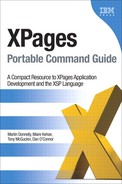Introduction
Welcome to the XPages Portable Command Guide! This book is designed, for the most part, as a quick information guide for XPages developers with some real-world experience under their belts. It focuses on the road less traveled—xsp.properties parameters, notes.ini settings, XSP JS object functions, and such. In other words, it covers the little-known magic bullets that are not well documented but invariably help get you out of a programming bind. In that sense, it is an ideal companion for more holistic tomes such as Mastering XPages, which is designed to give broad coverage to the runtime and application development experience in general. Having said that, this book does dive into detail, when appropriate—after all, the authors are developers, so we just can’t help ourselves!
XPages is a rich and powerful application development framework for Notes/Domino, first introduced in version 8.5 at Lotusphere 2009. Since that time, XPages has gone from strength to strength, with three further release updates, an open source XPages Extension Library, a dedicated IBM XWork server, a best-selling IBM Press book, and many other initiatives and innovations. We hope this Portable Command Guide helps add to the general success of XPages by bringing new information to the community and making application development a little bit easier for all concerned.
Reading Audience
This book is for XPages developers with some practical experience. Neophytes are advised to start with a more general book, such as Mastering XPages, or perhaps to use this book as its companion guide.
Conventions
Any programming code, markup, or XSP keywords are illustrated in numbered listings using a fixed width font.
User interface elements (menus, links, buttons, and so on) of the Notes client, Domino Designer, or any sample applications are referenced using a bold font. So too are file system paths, locations, and artifacts, such as the notes.ini and xsp.properties files.
Important words and phrases are emphasized using an italic font.
Visual representations of the design-time experience or runtime features are typically captured as screen shots and written up as numbered figures, using super-imposed callouts where appropriate.
In general, chapters feature a summary table of XPages commands, parameters, or properties near the beginning and seek to explain these in brief, concise terms. These items, or important subsets thereof, are typically then given more expansive treatment in the rest of the chapter. Most chapters also have an accompanying NSF sample application containing practical examples that can be perused using Domino Designer and run in preview mode for the web or Notes client. These samples are available online for download at the following website: www.ibmpressbooks.com/title/0132943050
The samples are based on the latest release of XPages available at the time of writing (version 8.5.3), although many examples work with earlier releases. Visit this website to download the no-charge version of Domino Designer 8.5.3: www.ibm.com/developerworks/downloads/ls/dominodesigner/
How This Book Is Organized
This book is divided into six chapters, to separately address the many different aspects of XPages software development in as logical a manner as possible.
• Chapter 1, “Working with XSP Properties,” gives you all the details you need to locate, edit, and load the xsp.properties file, and thus configure the XPages runtime for your own specific requirements. An XSP property is a simple parameter definition that can modify the behavior of the XPages runtime in “magical” ways.
• Chapter 2, “Working with Notes/Domino Configuration Files,” concerns itself with the practical business of identifying the notes.ini settings that have particular relevance to XPages and explains their usage in detail.
• Chapter 3, “Working with the Console,” gives an overview of the many ways you can interact with the XPages runtime at the console level for runtime analysis, troubleshooting, or application debugging.
• Chapter 4, “Working with the XSP Client Side JavaScript Object,” examines the XSP Client Side JavaScript Object and lists simple examples of all the publically exposed functions that that can be used in an XPage. It also provides a general overview of Client Side JavaScript scripting techniques and other miscellaneous features relevant to XPages development.
• Chapter 5, “Server-Side Scripting,” gives an overview of Server Side JavaScript scripting objects and supporting libraries. This chapter also examines ways to integrate custom Java classes and create Managed Beans.
• Chapter 6, “Server-Side Debugging Techniques,” provides detail on setting up a debug and logging environment for your XPages applications. It also explains the details of stack traces and how you can analyze and decipher such information when troubleshooting an application.
• Appendix A, “Definitive Resources,” points to a collection of definitive reference sources that describe all the details of the XSP tags and Java and JavaScript classes. It also points to specification documents that define the technologies that XPages consumes or extends.
• Appendix B, “Useful Online Resources,” gives a snapshot of the authors’ favorite XPages websites at the time of writing. This list of sites should help you find whatever you need to know about XPages that you cannot find in this book.
• Appendix C, “Make Your Own Journal,” provides blank pages for you to add your own specific notes on settings, markup, code fragments, or whatever else you need that might not be listed in this book.
